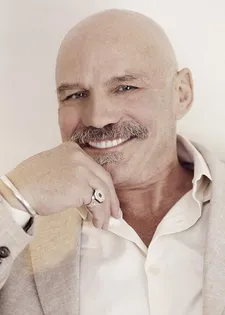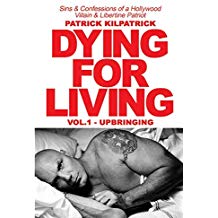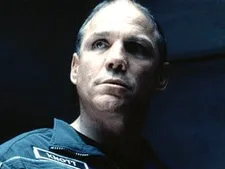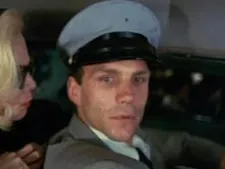 |
| Patrick Kilpatrick |
In a career that has spanned more than fifty films and a vast number of television appearances, Patrick Kilpatrick has played quite a range of characters but has become best known for his villains. Prior to his career as an actor he worked as a journalist and screenwriter, and he has published the first volume of an autobiography, Dying For A Living. In our wide-ranging interview we discussed his memories of director Nicolas Roeg, his experiences working alongside some of the industry’s biggest stars, the thrill of doing stunt work and much, much more. I began by asking about the film he’s shooting at the moment, mystery thriller Catalyst, in which he plays one of seven strangers who wake up trapped in a warehouse with no idea how they came to be there.
“It’s a very interesting project,” he says. “Chris Folkens, who’s the director, built this very structured environment scripturally and then there was room for a lot of improv within that. He did a lot of research on each character. I play a paedophile priest which was really interesting, to do the research on that. They’re good filmmakers and I’m excited to work with them. They’re really great. Chris, and then there’s David Bianchi who’s the producer – they’re very energetic and skilled young filmmakers.”
How does he feel about playing so many villains? Was it something he got into intentionally or did it just happen to work out that way?
“One of the purposes of writing Dying For A Living was to examine how that came about,” he says. “Some of it is typecasting but I’ll tell you a funny story: I finished volume one, which is all about my upbringing and writing career and playwriting and stuff in New York, and then I realised that in second grade or first grade, my school class had a play, The Pied Piper Of Hamelin, and they cast me as the villain! So whatever it was – I think it’s kind of an exuberance or recklessness or boldness – that came early on. Even when I was playing sports the coaches would let me do whatever I wanted to do and seek and destroy the opponents’ finest players, so I was given freedom to be kind of a monster from a very early age.
 |
| Dying For A Living |
“I think some of it is institutional typecasting, in television particularly, but fortunately independent films don’t really do that. Also, it’s really rich territory to work as an actor. I have no complaints.”
Is he particularly attracted to roles that give him room for improvisation and allow him some creative input?
“One good thing about me having begun as a writer for ten years is that it really is a great competitive advantage to be able to improv, because a lot of times the scripts will have places where they’re not fully realised. Even if you’re working on Minority Report with Steven Spielberg, he gives you the opportunity to play with all of that, and if you’re a verbal person, well, I like to throw in cultural references and all kinds of stuff, and then that gives them a lot to edit with. So sometimes you’ll get hired to play a thug but they get a criminal mastermind, and they’re always pleased to raise the intelligence of the character.”
In one of this earliest films, Insignificance, he worked with Nicolas Roeg, who recently passed away. I ask if he has memories of the great director that he’d like to share.
“Oh, I have such wonderful memories of Nicolas,” he says. “I remained friends with him throughout my life in Hollywood. In fact he had read the first draft of Dying For A Living. I wanted him to write the forward but he was just too ill. He liked the book a lot.”
He tells me about how, in the early days, Roeg used to praise his scripts to the point where he thought he was being teased, but it was all genuine.
 |
| Patrick Kilpatrick in Minority Report |
“He was very supportive and a very big fan of my writing. I’m so glad to have worked with Nicolas and Guy Hamilton, these wonderful British directors, early on in my career. I really respect those guys. As I say in the book, I didn’t know who Nic Roeg was but I stumbled into a theatre and I saw Don’t Look Now about two weeks before I was supposed to meet him. I wasn’t even in the Screen Actors Guild at the time. I was doing a play at a prestigious theatre in New York. So I go in, I’m all prepared to audition and I walked in and there he was, and having seen Don’t Look Now I realised he was a brilliant director, and I’d researched him a bit by then. I walked in and he said ‘What are you doing?’ and I said ‘Well, I’m playing opposite Brooke Adams in this play,’ and then I summoned all of my courage – I was a very young actor – and I said ‘and I’m looking forward to working with you.’ And he leaned forward and said ‘Well then shall we start tomorrow?’ And he didn’t even audition me.
“I find that really brilliant directors often don’t do that. Guy Hamilton didn’t do it and Spielberg didn’t do it. So my first Screen Actors Guild Scene – the casting people, by the way, very very upset that I wasn’t in the Screen Actors Guild at the time because it meant the production had to pay money to get me in the union. Nicolas seemed very taken by the fact that I could drive because I was playing Marilyn Monroe’s chauffeur. And of course I’ve been driving since I was about nine years old! He said ‘Patrick, now, this period Cadillac that you’re driving is worth more than the whole movie.
 |
| Patrick Kilpatrick in Nicolas Roeg's Insignificance |
“I had a wonderful time with him and Theresa Russell. Their relationship was really interesting to watch. He said ‘Patrick, I do a movie every two years and it instantly becomes a classic and doesn’t make any money.’ I was very sad to see him go. He was a very funny, very sweet guy. And a great visionary. People don’t really realise – they’re just now doing things in music videos and stuff that he was doing in the Sixties.”
He’s worked with some very big name stars over the years. Who has stood out out to him?
“I come from a journalistic background so I really love to observe all these people for their individuality and even the craziest ones make things interesting,” he says. “Generally I prefer working with actors, people who come from a stage or acting background rather than a sports background like Jean-Claude Van Damme or Steven Seagal or Chuck Norris, but those guys are really interesting in their own right too. I cover all of that in the book. I’ll tell you something about Sean Connery which I thought was brilliant. His real life accent is much more working class than the one that he presents to the world – so he’s actually acting all the time, which I find very interesting. He’s very much a movie star.
“I love just observing how people work and how they’re different from other people, what their persona was, how they relate to other people on the set – it’s a great privilege. One of the regrets I have is that I didn’t take pictures throughout this period, like Dennis Hopper did. But I always felt that taking picture, that energy took away from focusing on the acting. And of course cameras, they weren’t like point and shoot with your iPhone.”
Coming soon: Patrick recalls working with Arnold Schwarzenegger, Tom Cruise and Christopher Walken, and discusses his upcoming films Night Walk and Active Shooter.





















